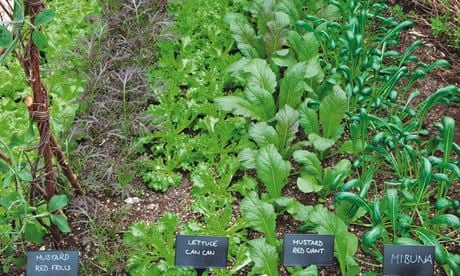If you took up my summer of salads challenge earlier this year, I hope you're enjoying a good harvest and didn't end up with more slugs than salads. Even if most of your lettuce got munched, don't give up: it's worth sowing some now, for harvesting this autumn and winter.
Salads that do well in cold conditions are oriental greens and hardier lettuces, and the good news is they are all as slug-proof as a salad can get. Get the timing right and this next stretch of growing is a doddle.
These salads are sown from the end of July to the end of September, allowing you to pick through autumn right the way to next spring.
Oriental greens have become a mainstay for autumn and early winter eating. Mizuna, mibuna, baby pak choi and the many and various mustards make excellent spicy salads that work well with the rich, comforting flavours of autumn and winter cooking.
The best mustards for salads are the streaked or frilled mustards (often sold as red or green frilled) that have a deeply cut filigree of leaves. The large-leaved sort such as giant red mustard, once mature, are too hot for salads and better cooked (cook very briefly or they become too bitter).
Most oriental greens are happy close together, 10-15cm apart for cut and come again, and 20cm for whole heads. The wider the spacing, the longer they will stand over winter. I start closely and thin as I go. Leave a couple of mizuna and frilly mustards with space to take on the tougher months.
Most oriental greens are in the brassica family and thus have those mustard/cabbage overtones. In the case of pak choi and mizuna, this is a slightly bitter note at the end; with mustards, it's a spicy bite; add into the mixture rocket (also a brassica), and you can end up with a salad that is too wasabi for its own good.
Cold weather makes these flavours more pronounced. If you protect leaves with a cloche, fleece or grow in a cool greenhouse you greatly temper them. Likewise, if they are under watered they will toughen and become too spicy.
Oriental greens like to germinate in warm soils and grow into cool conditions. If you sow in spring, they go straight to flower as the days lengthen and warm. Hence from the end of July onwards is the perfect time to sow.
Mostly slugs will stay clear, but flea beetle can be an issue. This tiny, metallic-hued beetle (it's just a millimetre or so long) likes to nibble the leaves into lace doilies. As their name suggests, these beetles jump – if you go down on hands and knees to look for them, they'll all hop to safety. The best way to keep them off is to cover seeds with Enviromesh. A few flea beetles do little damage, but a large population can slow growth.
If you want to be picking lettuce leaves at Christmas, sow in August, because by December light levels will be too low. These plants will give you leaves from mid-autumn to December. Lettuce sown at the end of September will sit doing little over winter, and will then put on rapid growth as the days lengthen – this is what you'll be picking next spring. It's important to sow in batches.
A fair few lettuce will go through winter in an unheated greenhouse or polytunnel ('Winter Gem', 'Tom Thumb' or 'Winter Marvel'), but outside you want varieties fit for purpose. One of my favourites is 'Winter Density', a hardy little gem variant, with dark green, crisp leaves.
'Marvel of Four Seasons' (or 'Winter Marvel') lives up to its name and is a handsome big butter-head; 'Valdor' and 'Arctic King' are two of the toughest. 'Rouge d'Hiver' is also tough and has a lovely red tinge to the leaves. It's slow to bolt in spring, too, so if you make a last sowing in early October, you can pick it well into April the following year.
If you are using the compost you started off the season with, add some extra food, either a new layer of compost to replenish the top or, better still, a handful of seaweed and chicken manure pellets as well.
Sow the seeds, barely covering them with a little extra compost, and water in well. At this time of year, if August is hot, growth will be fast for the brassicas, so the lettuce may need to be shaded for germination.
And my last tip is this. Damp leaves in winter go mouldy very quickly, so once the days shorten, water the soil and not the plants.
Seed offer
Feeling inspired? Order our salad seed collection and keep the growing season going for months to come. We're offering seven packets of salad seed chosen by Alys Fowler and five module sowing trays for £8.99: lettuces 'Arctic King' and 'Winter Gem', mooli radish 'Neptune', and salad leaf mixes 'Bright & Spicy', 'Niche Oriental Mixed', 'Cut'n'Come Again' and 'Frilly Mix' (prices include free UK mainland p&p). To order, call 0330 333 6856, quoting ref GU230, or go to visit our Reader Offers page. Delivery from this month.

Comments (…)
Sign in or create your Guardian account to join the discussion